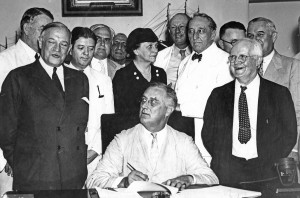Franklin Roosevelt was, among many other things, a knowledgeable forester. He frequently described himself as a “grower of trees.”
Long before his entrance on the political scene, he spent years reforesting his Hudson River estate at Hyde Park.
As governor of New York, Roosevelt established a “tree army” of unemployed young men to restore the state’s abused forestland. “Forests, like people, must be constantly productive,” Roosevelt told the Forestry News Digest.
After his presidential inauguration in 1933, at the depths of the Great Depression, with millions unemployed, he persuaded Congress to create a Civilian Conservation Corps (CCC) that, he said, would solve two crises by employing “wasted human resources to reclaim wasted natural resources.”

Planting trees, Mammoth Cave National Park, Kentucky
The CCC planted a billion trees in parks, national forests, and on spent farmland
Photo Credit: Creative Commons Creative Commons
Scholars are still not sure whether FDR was aware of the William James 1906 speech at Stanford, “The Moral Equivalent of War,” in which the eminent psychologist and philosopher seeks to replace war with its moral equivalent. In lieu of the destructive outcome of wartime patriotism, James called for constructive civil service in the interests of the individual and the nation. That is precisely what the peacetime army of the CCC did.
During its decade-long run, the CCC employed three-and-a-half million young men to plant over three billion trees.
Racially integrated outside of the South fifteen years before President Truman desegregated the Armed Forces, the “Cs” recruited jobless, indigent, and often illiterate young men and gave them nutritious food, housing, health care, education, and hard work in some of the most rugged and beautiful places in the nation.

Fighting Fires, 1936
CCC enrollees battled wildfires and provided flood relief
Photo Credit: Idaho Department of Forestry
They fought beetle infestation and blister rust as well as forest fires, conserved soil, and were on call to help in the natural disasters—epic floods, hurricanes, and drought—that added to the hardships of the 1930s.
The CCC also left a vast legacy of superb rustic structures in national and state parks and wildlife refuges whose expansion and development during the 30s they were largely responsible for. Many CCC veterans recalled their service as among the happiest times of their lives and attributed it to success later in life.
After decades of tax cuts our national, state, and local jurisdictions are today incapable of dealing with the ever-growing danger of conflagrations such as those that recently devastated California, and the hurricanes from which Florida, Houston, and Puerto Rico are struggling to recover.
Representative Marcy Kaptur (D-OH) has introduced the 21st Century Civilian Conservation Corps Act, HR 2206, reviving a proven model to address chronic unemployment, heal our forests, and meet the challenges and consequences of climate change. It deserves our support.

The president and key CCC staff, 1933
Big Meadows CCC camp, Shenandoah Valley, Virginia. Front row, left to right: Interior Secretary Harold Ickes, CCC Director Robert Fechner, FDR, Agriculture Secretary Henry Wallace.
Photo Credit: Courtesy FDR Library






